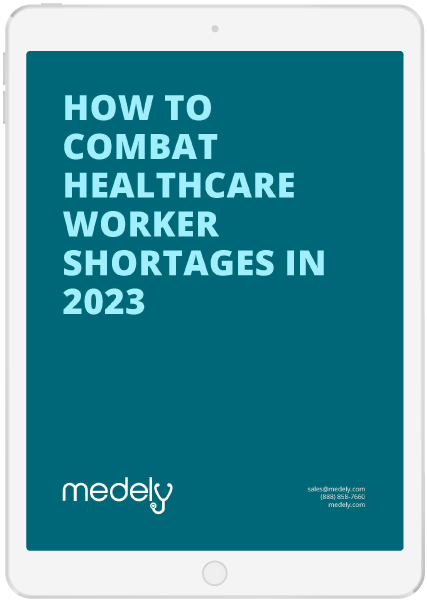Hospitals have faced significant challenges in the past several years, and like many healthcare facilities, staff in hospital settings have had to balance their patients’ needs as well as their own mental and physical well-being. With widespread stress and burnout among nursing staff and staffing shortages, which started during the pandemic and continue to this day, facility managers need to understand how to prevent nurse burnout in hospitals through more creative steps. In this post, we’ll define burnout in more detail and identify strategies you can take to improve staffing by adding per diem nurses and additional flexibility into your workforce to help reduce burnout and churn at your hospital.
Burnout in Nursing
Burnout is a common occupational condition that occurs due to chronic workplace stress. This condition is defined as experiencing feelings of:
- Mental and physical exhaustion
- Mental distance from work
- Cynicism about work
- Reduced efficacy at work
Burnout among healthcare professionals is very common. Nursing and hospital staff have complex responsibilities to their patients, along with the administrative responsibilities associated with nursing.
In addition, nurses may feel a sense of moral injury if they are frequently unable to offer the care they feel patients need. This can happen due to time constraints, lack of coordination with outside doctors or other staff, or poor facility management, contributing to frustration, a sense of powerlessness, and guilt.

Strategies to Prevent Nurse Burnout in Hospitals
Nurses and managers benefit from understanding the causes and effects of burnout. Developing open lines of communication and trust can help nurses ask for the help they need to continue to provide the best patient care.
- Awareness: Managers and nurses alike need to recognize the signs of burnout before implementing strategies to prevent nurse burnout in hospitals. Offering learning opportunities to discuss burnout causes and symptoms can give nurses and their supervisors the tools to identify burnout before it becomes a significant issue. There are also online tools, such as a Burnout Self-Test, that individuals can use to take inventory of their emotional state.
- Prioritize wellness: Encouraging staff to take care of themselves can be an effective way to mitigate workplace stress. Ensuring that they have time in their days to take breaks, eat, hydrate, and rest will contribute to their overall well-being. Facility managers can create opportunities for staff to engage in self-care. Organized activities like exercise classes or group walks, free snacks or meals for staff, presentations by self-help experts, and social gatherings outside work can improve morale and build camaraderie.
- Employee assistance programs: Employee assistance programs (EAP) are a benefit some workplaces offer to staff. EAPs provide staff with mental health assessments, short-term counseling, referrals, and follow-up services. Making staff aware of any available EAP benefits gives them an easy way to get help for burnout.
How Understaffing in Hospitals Can Increase Burnout
An estimated 1.5M health professionals left their jobs in healthcare in the first two months of the COVID-19 pandemic. Many have returned to the workforce since then, but employment in healthcare remains lower than pre-pandemic levels, with workers down by 1.1%, or 176K, compared to February 2020, according to the U.S. Bureau of Labor Statistics.
Burnout is exacerbated by working more hours and working in understaffed facilities. Understaffing means nurses have to take on more shifts to cover shortfalls and do more work while on shift. This exacerbates existing stress and burnout, which directly contributes to nurse attrition. A 2021 JAMA report showed burnout is a leading reason nurses leave their jobs.

How Staffing Strategies Can Prevent Nurse Burnout
Taking steps to address staffing shortages is one-way hospital staff and nursing managers can prevent nurse burnout. Working with staff to understand what they would like and implementing new staffing strategies can improve workplace morale and increase employee retention.
- Flexible scheduling: Flexible schedules can help staff create a better work-life balance. Managers can offer options such as 4-, 6-, 8-, and 12-hour shifts and consider staff preferences about what time of day they work. Flexible time off policies and schedule-change protocols can also improve work-life balance for staff and improve workplace satisfaction.
- Duty changes: Changing responsibilities or work locations can give nurses a mental break from a stressful routine. If your facility has multiple sites, staff might benefit from moving between locations. Scheduling nurses for “swing shifts,” where they help as needed instead of being assigned to particular patients, can be a break from the intensive work of patient interaction. Opportunities for advancement can also motivate staff and increase retention.
- Additional support staff: Adding non-nursing staff to your facility’s roster can ease nurse workloads. Non-medical staff can help with patient needs such as meal delivery, signing in visitors, bringing patients items they need, or helping with tasks like opening curtains or fetching more blankets. This frees nurses up to focus on medical care tasks.
- Leverage an extended workforce: Access to a pool of per diem or assignment-based nursing staff can help managers fill in staffing gaps quickly. On-demand staffing gives managers a simple way to bring in additional nurses to cover shifts as needed.
Medely is an on-demand staffing solution for managers at hospitals, post-acute care facilities, skilled nursing facilities, and surgery centers. Our service provides easy access to a highly skilled pool of nurses and allied health professionals qualified to fill per diem and assignment requests. Professionals working with Medley are thoroughly vetted, including background checks, and we ensure they have the proper credentials to work in your facility.
Medely’s easy-to-use booking platform gives you the direct, on-demand staff you need to meet your scheduling challenges and help you prevent nurse burnout at your hospital. To learn more about how Medely provides staffing solutions for your post-acute care facility, contact us or set up your free account and get started right away.

How to effectively combat healthcare labor shortages in 2024
Learn how to effectively combat healthcare labor shortages with an extended workforce to maintain continuity of care and gain access to tools you can use to manage your extended workforce more effectively and efficiently. In this eBook, you’ll learn:
- ■ Why nurses are leaving full-time jobs behind.
- ■ The factors impacting healthcare professional employment.
- ■ How you can use an extended workforce to meet demand.
- ■ How you can use data-led staffing planning to manage costs.



